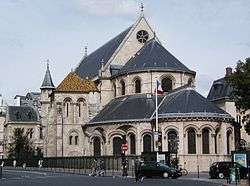3rd arrondissement of Paris
| 3rd arrondissement of Paris | |
|---|---|
| French municipal arrondissement | |
|
Arts et Métiers (medieval priory of Saint-Martin-des-Champs), in the 3rd arrondissement of Paris | |
 Paris and its closest suburbs | |
| Country | France |
| Region | Île-de-France |
| Department | Paris |
| Commune | Paris |
| Government | |
| • Mayor | Pierre Aidenbaum |
| Area | |
| • Total | 1.17 km2 (0.45 sq mi) |
| Population (8 March 1999 census)[p] | |
| • Total | 34,248 |
| • Estimate (2005) | 35,100 |
| • Density | 29,000/km2 (76,000/sq mi) |
| ^[p] Population sans doubles comptes: single count of residents of multiple communes (e.g. students and military personnel). | |
 20 arrondissements of Paris | |||||||||||||||||||||||||||||||||||||
|---|---|---|---|---|---|---|---|---|---|---|---|---|---|---|---|---|---|---|---|---|---|---|---|---|---|---|---|---|---|---|---|---|---|---|---|---|---|
| |||||||||||||||||||||||||||||||||||||
The 3rd arrondissement of Paris, situated on the right bank of the River Seine, is the smallest in area after the 2nd arrondissement. The arrondissement contains the northern, quieter part of the medieval district of Le Marais (while the 4th arrondissement contains Le Marais' more lively southern part, notably including the gay district of Paris). The oldest surviving private house of Paris, built in 1407, is to be found in the 3rd arrondissement, along the rue de Montmorency.
The ancient Jewish quarter, the Pletzel (פלעצל, little place in Yiddish) which dates from the 13th century begins in the eastern part of the 3rd arrondissement and extends into the 4th. It is home to the Musée d'art et d'histoire du judaïsme and the Agoudas Hakehilos synagogue designed by the architect Guimard. Although trendy boutiques are now taking up many of the storefronts, there are still landmark stores selling traditional Jewish foods.
A small but slowly expanding Chinatown inhabited by immigrants from Wenzhou centers on the rue au Maire, near the Conservatoire National des Arts et Métiers housed in the medieval priory of Saint-Martin-des-Champs.
Geography
With a land area of 1.171 km2 (0.452 sq.miles, or 289 acres), the 3rd arrondissement is the second smallest arrondissement in the city (after the 2nd arrondissement).
Demography
The area now occupied by the third arrondissement attained its peak population in the period preceding the re-organization of Paris in 1860. In 1999, the population was 34,248, while the arrondissement hosted a total of 29,723 jobs.
Historical population
| Year (of French censuses) |
Population | Density (inh. per km²) |
|---|---|---|
| 1861 (peak of population)¹ | 99,116 | 84,642 |
| 1872 | 89,687 | 76,656 |
| 1954 | 65,312 | 55,822 |
| 1962 | 62,680 | 53,527 |
| 1968 | 56,252 | 48,038 |
| 1975 | 41,706 | 35,616 |
| 1982 | 36,094 | 30,823 |
| 1990 | 35,102 | 29,976 |
| 1999 | 34,248 | 29,247 |
| 2009 | 35,655 | 30,474 |
¹The peak of population actually occurred before 1861, but the
arrondissement was created in 1860, so we do not have figures before 1861.
Immigration
| |||||||||||||||||||
Education
Schools include:
Map


Places of interest
- Le Marais (shared with the 4th arrondissement)
- Carnavalet Museum
- Conservatoire National des Arts et Métiers - main campus
- Le Défenseur du Temps
- Institut Tessin
- Musée des Arts et Métiers
- Musée de la Chasse et de la Nature
- Musée Cognacq-Jay
- Musée de l'Histoire de France
- Musée de la Poupée
- Musée de la Serrure
- Hôtel de Soubise
- Former Temple fortress
- Carreau du Temple
External links
| Wikimedia Commons has media related to Paris 3e arrondissement. |
 3rd arrondissement travel guide from Wikivoyage
3rd arrondissement travel guide from Wikivoyage- The official guide, partner of the Paris Tourist Office
Coordinates: 48°51′49.75″N 2°21′41.97″E / 48.8638194°N 2.3616583°E

